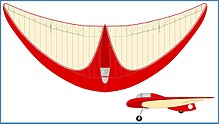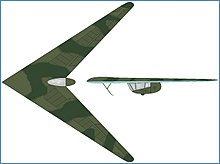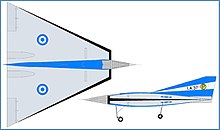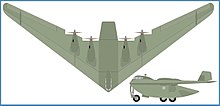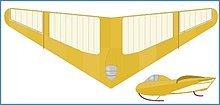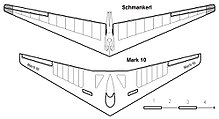Brothers hoarding
The brothers Reimar (born March 2, 1915 in Bonn ; † March 14, 1994 in Argentina) and Walter (born November 13, 1913 in Bonn; † December 10, 1998 in Baden-Baden ) Horten lived in Bonn-Poppelsdorf. The two autodidacts were pioneers in the development of the flying wings - airplanes that they tried out at Bonn-Hangelar Airport .
The brothers received great support from their parents. It is reported that they even used the family's dining room as a workshop at times. The third brother Wolfram (born March 3, 1912 in Bonn; † May 20, 1940) died in a Heinkel He 111 near Dunkirk during World War II .
Interwar period
The Horten brothers were still toddlers during the First World War . As she grew up in the post-war period, she also introduced aviation technology at an early age.
Hoarding HI
At a young age they first built flying flying wing models, from 1933 ( Horten HI ) gliders followed, which performed quite successfully in competitions.
Hoarding H II
In 1934/1935 the H II Habicht followed , in which the pilot flew in a lying position. The H II was later equipped with a Hirth HM 60 engine with 60 hp. Among other things, a test report has been received from the aviator Hanna Reitsch about a flight under the registration number D-11-187 , which documents the various peculiarities of the model and, among other things, notes that her arms were too short to operate the landing gear lever.
Hoarding H III
In 1936 the Horten brothers became officers in the German Air Force. In 1937 Walter ordered three H IIs to be built in Lippstadt , but this time with a seat for the pilot. Motors could no longer be installed. Reimar was transferred to Cologne . There he built the H III , which was essentially similar to the H II, but had a larger wingspan . About 13 copies were built, some took part in the 1938 and 1939 gliding championships in the Rhön . In addition, the H IIIc was created with slats . In 1938 an H III reached an altitude of almost 7,000 meters.
The H III is said to have also been called the Horten Ho 250 .
Hoarding HV
In 1938/1937 the Horten brothers developed the HV with the support of Dynamit Nobel AG , which wanted to test their plastic " Trolitax " on the HV . During the test flight of the twin-engine machine with pusher propellers, they crashed, but only suffered a broken jaw and the loss of a tooth . The engines were then moved further forward and fitted with a longer propeller shaft. The H Vb, in which no Trolitax was used, was flown successfully in 1938, but then shut down because of the war.
Hoarding parable
In 1938 the “ parabola ” was built to investigate the center effect , the shape of which is reminiscent of a seed leaf of Zanonia . Over the winter, however, the aircraft warped so much that it was burned without ever having flown.
Start of the Second World War
Negotiations with Heinkel and Messerschmitt in 1939 failed. At the beginning of the war, Walter first became a fighter pilot as a technical officer and flew a Bf 109 on the western front until all technical officers were recalled from the front. He was at times a Rottenflieger of Adolf Galland and scored nine kills in the Battle of Britain . After Galland's appointment as general of the fighter pilots on November 22, 1941, Walter Horten remained in his staff in Berlin and was a. a. also involved in training Wolfgang Späte to project X (= Me 163 ).
Reimar was also trained to be a Bf-109 pilot, but then came to a gliding school, where some crane gliders were already being prepared for the Operation Sea Lion to transport ammunition in order to convert some Horten H IIIb as well.
The fact that the brothers were able to continue their developments during the war years can certainly be viewed as unusual and can certainly be traced back to Walter Horten's direct proximity to some leading personalities within the Air Force, which of their projects (H IV – H IX / Go 229) are more or less “semi-officially”. It can be assumed that the failure of the Me 163 was already becoming apparent and that the development of an alternative model (Ho IX / Go 229) for the JG 400 was therefore sought. However, there is no known evidence that an official order for "Hitler's stealth bombers" was ever given. It was only when the Horten brothers responded to Göring's 1000/1000/1000 tender that the development of the Horten flying wings became official with the establishment of Sonderkommando IX.
Hoarding H IV

When preparations for the invasion of England were canceled in 1940/41, members of the Air Force built the high-performance sailor Horten H IV in Königsberg . The pilot took a kneeling position in this aircraft, Heinz Scheidhauer carried out the maiden flight . Three more H IV were built in Göttingen .
The H IV is said to have been referred to as Horten Ho 251 .
Hoarding H IIIb
Then an H III b was built, which was powered by a Walter Mikron motor.
Hoarding H VII
In order to test the Schmitt-Argus pulse engine , the two-seater Horten H VII was built, which had two thrust propellers and offered the option of attaching a pulse engine. However, this was never installed. The H VII was used as a trainer aircraft . At the end of March 1945 an order was placed for 20 machines that were intended as training aircraft for the planned use of the Ho 229.
Hoarding H IIIe – g
As a result, more H IIIs were built: one H IIIe with a VW engine, three H IIIf with a lying pilot position and two H IIIg two-seaters.
Hoarding H VI
The Horten H VI was a pure high-performance sailor. It was created on the basis of the Horten H IV, but with a larger span. The first of a total of two sailors built was flown for the first time at the end of 1944. The flight characteristics were very good.
Hoarding H VIII
The design for a Horten H VIII was not realized. He envisaged two fuselage attachments: one to transport loads and one as a “flying wind tunnel ”.
Horten H IX / Ho 229 / Go 229 (for Gotha 229)
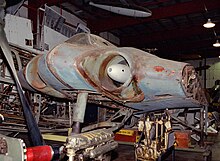
When the Junkers Jumo 004 jet engine was available in 1943 , the Horten brothers were working on an aircraft that was supposed to meet the "1000-1000-1000 specification" required by Hermann Göring : it was supposed to carry 1000 kg bombs at 1000 km / h for 1000 km can carry. The flying wing Horten H IX was built in Göttingen under the name “Sonderkommando IX” - a two-jet engine made largely of wood, which flew for the first time in 1944, but which crashed during a later test flight after an engine failure.
The series version should have the designation Horten Ho 229. A modified H III - the H XIII - and two H VI were used for further flight tests, mainly to investigate the "center effect ". A copy of the H IX was brought to the USA by the US Army in 1945.
Hoarding H IVb
In December 1944, a copy of the Horten H IV was built in Bad Hersfeld with a laminar profile wing and designated as the H IVb. The profile was copied from a North American P-51 after surprisingly low resistance values had been measured in wind tunnel tests by the DVL . During a test flight on January 18, 1945 near Göttingen, the plane crashed in a tailspin, whereby the pilot was able to get out, but his parachute no longer opened. The production of a further ten copies was stopped after the accident.
Hoarding H XII
Another project that made use of this wing profile was the two-seater Horten H XII , which was supposed to be powered by a 90 hp DKW engine. This aircraft was subjected to a short test flight at the end of 1944, which, however, was too short to be able to adequately assess the wing properties. At that time, the aircraft was not yet motorized.
Hoarding HX
The Horten HX is the designation of a supersonic aircraft with a conventional vertical tail that was made in Bad Hersfeld . Several models were being built and a sailor was under construction when the Americans arrived in 1945 - the sailor had previously been destroyed.
Hoarding H XI
The Horten H XI was a glider with a wingspan of 8 meters and aerobatic capabilities that was built in Bad Hersfeld.
Hoarding H XIII
The Horten H XIII was a glider with a very strong sweep (60 ° at the leading edge). The cockpit was mounted below the wing, the control stick hung from above. The wings of an H III were used.
This glider delivered the first manned test results for the planned later supersonic flight with the H X. Because the HX supersonic project was to be kept secret, the designation “XIII” was used instead of “X”. The test results showed a satisfactory behavior. Only the rolling effect was hardly present at speeds above 150 km / h. On the first landing, the machine collided with a fence, probably due to the underestimation of the ground effect, which led to an extended approach path.
Hoarding H XIV
In April 1945 a scaled-down version of the H VI was completed, the H XIV . The attempt to hide them and smuggle them through the American front failed. The plane was discovered and destroyed.
Hoarding H XVIII
On March 12, 1945, a contract was signed for the development of the Horten H XVIII - a long-range flying wing bomber that should be able to bomb the United States .
At Hermann Göring's insistence, production was to begin on April 1, 1945 in and on the Walpersberg near Kahla . A 100-meter-long wooden “research hall” owned by the Horten brothers stood on the north side of the mountain. According to contemporary witnesses, the hall was completely deserted when the Americans arrived on April 12, 1945. Evidence of the start of production is still missing today.
post war period
After the war, the development of new aircraft in Germany was banned until 1950. In the USA in 1946 they were suspected of being the originator of the first UFO sightings, for example in New Mexico and Nevada. The US authorities had more than 100 agents searched for the brothers across the zone, but then mistakenly believed them to be in the USSR. In order to be able to continue working, there were initially contacts with Great Britain , but since there were no concrete contracts, they initially stayed in Germany. Reimar studied mathematics. In 1947 Walter applied to the US aircraft manufacturer Northrop , which had also been designing aircraft based on the flying wing principle for a long time. As a result, the company founder and aircraft developer Jack Northrop contacted Reimar, but there was no collaboration.
I. Ae. 34/41 / Horten H XV
Reimar Horten therefore finally went to Argentina in 1948 to the Instituto Aerotécnico (I.Ae.). In the same year, under the name FMA I.Ae. 34 “Clen Antú” (manufacturer FMA = Fábrica Argentina de Aviones ) initially built four two-seater gliders - the Horten internal name was H XVa. It was followed by two copies of the single-seat variant, the I.Ae. 34M or H XVb. The demand from glider clubs for an airplane with two seats arranged side by side led to the construction of four I. Ae. 41 or H XVc. On October 30, 1956, Heinz Scheidhauer was the first person to fly over the Andes in a glider . Four more copies of this type were built in Germany according to incomplete plans.
Hoarding H XVI
In 1950 the H XVI "Colibri" was built for a glider club in Buenos Aires . It should be small and easy to fly. During the first test flight, Scheidhauer lost control during a tow start and the aircraft crashed on the ground. Heinz Scheidhauer suffered only minor injuries.
Hoarding Ho 33
When it became possible to build gliders again in Germany in 1951, Walter Horten, who had remained in Germany, began to build a flying wing model called the Horten Ho 33 based on the H III . This was then built by Alfons Pützer KG in Bonn . A 50 HP Z9-092 engine from Zündapp should be used as the engine . The aircraft was initially built as a glider due to the still valid construction ban for motorized aircraft, the first flight took place in 1954. The motorization and provisional traffic approval (code: D-EJUS) was carried out by the Aviation Science Association Aachen 1920 e. V. (FVA) under the project name FVA-17. The first powered flight could not be carried out until 1957. Just three years later, the aircraft (which had become too heavy due to the modifications) had to be scrapped due to gluing errors. As early as 1955, a second example with a Porsche engine was built, registration D-EGOL, which today belongs to the Wasserkuppe Museum and was dismantled there as a glider V 1 with defects.
I. Ae. 37/48
In the 1950s, on behalf of the Argentine government, the delta wing I.Ae 37 was built with a lying pilot position, which had excellent flight characteristics. Based on this, the concept for a two-seat supersonic aircraft called the I.Ae 48 was developed. Both were surprisingly stopped by the government, officially for reasons of funding, but it is believed that the global move away from Delta aircraft at that time was the real cause. The strength between Mach 1 and Mach 2, which is typical for the wing shape, does not seem to have been a decisive criterion for this decision.
I. Ae. 38
1950 also marked the beginning of a project for a flying wing cargo aircraft called I.Ae. 38 . The trigger was the demand to be able to transport oranges from the Argentine province inexpensively over 1000 km to Buenos Aires . The control kinematics was taken over from the Horten H II. The aircraft was to be propelled with four engines and pusher propellers. The first flight could not take place until 1960. However, the aircraft was subsequently scrapped and the project ended.
Hoarding H Ib
Also in 1950 in Argentina the construction of a revised version of the HI began, the H Ib, which was completed in 1954 and then flew successfully for 25 years. After that she stood in an aircraft hangar for several years. She was extensively restored in 2007 and made her second successful maiden flight on February 1, 2008.
Horten runway sailors HX "Alita" and Horten HXc "Piernifero"
In 1954, a number of very small, lightweight, undercarriage-less micro-gliders were built under the designation H X , which was already in use in 1945 . The pilot was half lying in the wing and was able to pull his legs into the wing after take-off and support them on rests. The landing took place on the skid. A further development called PIERNIFERO is exhibited in the Museo Nacional de Aeronautica in Buenos Aires next to an I.Ae.41.
At the beginning of the 1990s, the desire for more powerful sports equipment arose in the hang-gliding scene. At the same time, the autobiography of Reimar Horten was published and so some hang-gliders, model builders and amateur aircraft builders turned to him to dare to create their own designs based on his design principles. A plastic version of the HX “Alita” was created with the Markmann “Mark10 ”. Another flying wing called “Schmankerl” , which can be started, was manufactured by Manfred Böhm in Effeltrich in a fabric-covered plastic construction and flown in by Thomas Amberger. The delicacy had a wingspan of 12 m and an empty weight of 45 kg. The construction of the Schmankerl and the Mark 10 was preceded by a six-month stay by Markmann and Böhm in Australia, where a similar design with a 15 m span was created together with Bill Moyes . All of these drafts (as well as those mentioned below) were supported by Reimar Horten until his death and in some cases also recalculated.
Christiani / Schäfer - "Aachen"
1993–95 the single-seat ultralight aircraft "Aachen" was created. The machine is driven by a 40 HP Göbler-Hirth motor and has a span of 13.2 m. The flight characteristics were very satisfactory, and a series production was considered. It is controlled by elevons and the rotating rudder.
PUL 10
Most recently (milestones 1992 to 1997) with the support of Reimar Horten at Nurflügel Flugzeugbau, the PUL-10 , a small flying wing light aircraft with a propeller and two seats next to each other, was created. In 2017, HORTEN Aircraft GmbH implemented a successor, the HX-2 , which is designed for alternative drives and is intended for later series production.
literature
- Andreas Haka: wings made of "black gold" . In: NTM Journal for the History of Science, Technology and Medicine . tape 19 , no. 1 , February 2011, p. 69 , doi : 10.1007 / s00048-011-0047-4 .
- Reimar Horten, Peter F. Selinger: Nurflügel, the history of the Horten aircraft 1933-1960 . 2nd Edition. H. Weishaupt Verlag, Graz 1983, ISBN 3-900310-09-2 .
- Uwe Jack: Hoarding flying wing jets. High tech in World War II . PPVMEDIEN, Bergkirchen 2015, ISBN 978-3-95512-084-9 .
- Rudolf Storck: Flying wings. The historical development of the world's tailless and flying wing aircraft. Bernard & Graefe Verlag, Bonn 2003, ISBN 3-7637-6242-6 .
- David Myhra: The Horten brothers and their all wing aircraft . Schiffer-Verlag, 1994, ISBN 0-7643-0441-0 .
Web links
- Hoarding flying wings. The Nurflügel Page (English)
- Hoarding designs. TWITT - The wing is the thing (English)
- Hoarding Nurflügel (Flying Wing) Panek Ultralight 10. Video on Youtube
- Flight with the H1b. Video on Youtube
- Hoarding HXc Moyes. Description of the runway sailors by Bill Moyes / Manfred Böhm (English)
Individual evidence
- ↑ Douglas Bullard: The Ho II “Habicht” Motorglider. In: Nurflugel.com. Accessed December 31, 2019 .
- ^ A b Andreas Parsch: German Military Aircraft Designations (1933–1945). In: Designation-Systems.Net. November 23, 2009, accessed December 31, 2019 .
- ^ William Green, Gordon Swanborough: Horten Exotica .. to the H IX and beyond . In: AIR Enthusiast Thirty-nine , p. 7
- ^ Anni Jacobsen: Area 51. An uncensored history of America's top secret military base. London 2011.
- ↑ Restauration Horten 33. (No longer available online.) Rhönflug Oldtimer Segelflugclub Wasserkuppe e. V., formerly in the original ; accessed on February 2, 2020 . ( Page no longer available , search in web archives )





